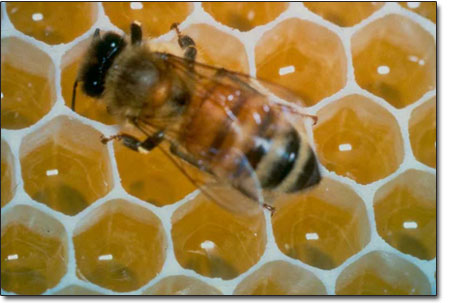|
| ||
| True bee-lievers
by Ari LeVaux Rare Hawaiian Organic White Honey, produced by Volcano Island Honey Co., is one of the most expensive honeys in America. Pearly white, with a delicate flavor that raises eyebrows and shuts eyes, it sells easily at $20 for an 8-oz jar. The catch, explains company founder Richard Spiegel, is that much of the honey is sold off-island. And while customers willingly pay the cost of shipping, more carbon dioxide gets into the atmosphere that way, contributing to global warming. Balancing finances with high ideals has become the central focus of Spiegel’s experiment at managing a small business that values sustainability and justice over profit. And the stakes couldn’t be higher. “I’ve been trying to change the world since forever. I started as a lawyer, but that wasn’t doing it,” he said. Addressing a group of college business students visiting from New York, Spiegel recounted his subsequent career paths, including migrant picker, hippie, backwoods cabin-dweller, founder and executive director of West Hawaii Mediation Center (an alternative to the formal legal system), and for the last 25 years, beekeeping and managing his values-based business, where the bottom line is less important than the big picture. A values-based business, he explained, means working slowly enough to protect bees from being crushed. It means paying your staff to swim in the ocean after a sweaty afternoon. It means giving preference to local markets, even at a major discount, because marketing locally is better for the earth. The great demand for this unique honey is, of course, irrevocably intertwined with its rarity. And so is the supply, which is limited to a forest of kiawe trees clinging to a lava flow on Hawaii Island’s western coast. Kiawe, a close relative of mesquite, has the ability to grow on bare lava, make a canopy and thus create a humid, buzzing, chirping forest. The air is cooler in the forest. It’s sleepy and peaceful. “It’s a real oasis,” says Spiegel, of the forest that produces his honey. Like much of Hawaii, kiawe trees are beautiful, tough and sharp. Kiawe is a legume, which means it adds nitrogen to the soil, spurring the growth of the oases it nurtures. The pods are edible to man and cow. The wood is hard, good for fence posts and barbeque. The young shoots produce thorns long enough to pierce a truck tire. Introduced to Hawaii by a French priest, kiawe trees dispersed widely among the islands. Nonetheless, according to Spiegel, there’s only one place with a critical mass of kiawe trees both isolated enough to ensure that bees will visit only kiawe flowers, yet large enough to keep enough bees busy to run a viable kiawe honey operation. Only one forest satisfies all of those criteria, and last year nearly half of it – 400 acres worth – burned down. Although the hives were saved, Spiegel’s small business had to downsize a few notches more, shedding seven of 12 employees. Meanwhile, a developer wants to build a golf course/condo development where the remaining forest is. One might expect that conservation easement buyers, like the Nature Conservancy, would jump at the chance to preserve the remaining 600 acres of such a unique forest. But there is little interest in preserving a forest of what amounts to an invasive species. So, unless something like $14 million comes his way, Spiegel’s Rare Hawaiian Organic White Honey might get a lot rarer. But that’s the least of his concerns. Last year, a beekeeper on the nearby island of Oahu discovered Varroa mites in some abandoned hives. Island-wide screening turned up the mites in numerous parts of Oahu. These bugs, which can destroy entire bee colonies in gruesome fashion, are difficult if not impossible to eradicate, and they are now just a boat or plane ride away from the other Hawaiian islands, including the big one. Honey production on the Big Island, meanwhile, though considerable, is eclipsed by another related industry that’s also vulnerable to Varroa mites: queen bee production. Every bee colony requires a queen bee, and since the process of producing queens is difficult, most honey producers buy them. The Hawaiian Queen Co. Inc., one of three queen bee vendors on the Big Island, ships as many as 8,000 queens a month, with a two-year waiting list worth of queen bees already spoken for. Worldwide, owner Michael Krones estimates, there is a deficit of half a million queens. Part of the current demand for queens has been fueled by yet another challenge to the bee and honey industry: colony collapse disorder. For reasons unknown, worker bees have been disappearing from their colonies, causing them to collapse. While this is a major problem worldwide, luckily for Spiegel, small and localized operations like his seem to be less vulnerable to colony collapse disorder. So, he carefully beekeeps on. Andrea Dean, Spiegel’s business manager, spoke for a few minutes to the visiting business class, hoping to explain Volcano Island’s recent attempts to calculate its carbon footprint. “Who’s heard of the greenhouse effect?” she asked. “It’s like, the plants, they release water, which becomes clouds,” came the only reply. This is why, even as the honey threatens to run dry, the need for educating about bees and the environment is all the more pressing. And this is why Spiegel, Dean and their busy bees keep on buzzing around what’s left of their trees. Between teaching the youth, tending the business, making a little honey, saving the world, and once in a while swimming in the ocean, there is so much work to do. •
|


